What Types Of Lifeboats Are Used On Ships?
Since the Titanic tragedy, it has been mandatory for ships to carry enough lifeboats for everyone aboard.
Back then, you could have a few open boats stored on deck. Now, you need enough capacity in lifeboats that have been specifically chosen for the vessel’s operational requirements. To achieve that, there are numerous types of lifeboat available.
Modern lifeboat designs include:
- Open lifeboats
- Partially-enclosed lifeboats
- Totally-enclosed lifeboats
- Free-fall lifeboats
- Hyperbaric lifeboats
- Lifeboats with a self-contained air support system
- Fire-protected lifeboats
- Lifeboat tenders
- Rescue boats
- Fast rescue boats
- Liferafts
Each type of lifeboat has advantages and disadvantages. Open lifeboats, partially-enclosed lifeboats, and totally-enclosed lifeboats are each designed for different environmental conditions and capacity requirements.
Others, like the hyperbaric lifeboats, have been specifically designed for one industry. Hyperbaric lifeboats are there for an abandon ship situation on a dive support vessel where divers are living in a hyperbaric chamber on board.
General lifeboat requirements
Regardless of what type of lifeboat a ship carries, it needs to meet some basic requirements to qualify as a lifeboat.
These requirements are listed with the LSA Code from the International Maritime Organisation, enacted into law by governments around the world.
For example, lifeboats can only carry a maximum of 150 people. Testing is carried out under the assumption that each person weighs 75kg and they are wearing a lifejacket.
Having seen these “capacity tests” carried out on passenger ships, a filled lifeboat is a cosy environment. These tests were conducted with crew members, so swapping them with passengers will make it an even tighter fit. None-the-less, the boats are designed with a significant margin of safety in mind.
Regarding propulsion, lifeboats must be able to travel at a speed of at least 6kn for at least 24hrs. When towing the ship’s largest liferaft, it must achieve at least 2kn. With the exception of freefall lifeboats, you also need to be able to row the lifeboat.
As for strength, the boat needs to be strong enough to withstand loads significantly higher than those it would be subjected to during normal launching and operation. For example, impacts against the ship’s side, or a 3m drop into the water.
General lifeboat requirements apply to all boats that are classified as a lifeboat. In addition to that, most categories have extra requirements they need to meet which we will discuss in the sections below.
Open lifeboats

Open lifeboats, as the name suggests, are completely open to the elements. They offer minimal protection to their occupants.
In the past, open lifeboats were the only ones that were carried on ships. You may remember the film “Titanic”, where they showed all the open lifeboats that she carried. Titanic wasn’t unusual, all other ocean liners also carried open lifeboats at that time.
As safety has improved, open lifeboats have been replaced with other types of boat that have been designed to offer better protection to their occupants.
Nowadays, you are most likely to find open lifeboats on older, or classic ships.
Apart from the lack of protection for their occupants, open lifeboats do suffer from other drawbacks as well.
They are more susceptible to filling with rainwater or spray that falls on the deck. Not only does water affect the boat’s weight, but the prolonged submersion of parts inside the boat also leads to their deterioration.
The reduced protection inside an open lifeboat makes it harder to maintain and service machinery and equipment. It is harder to have fixed electronic communication equipment and an engine.
Despite all that, open lifeboats are still used on ships today.
Partially-enclosed lifeboats
A partially-enclosed lifeboat is a lifeboat where at least 40% of the boat is covered by a rigid cover, and the rest with a permanently attached foldable canopy. It provides its occupants with a weatherproof shelter to protect them from exposure.
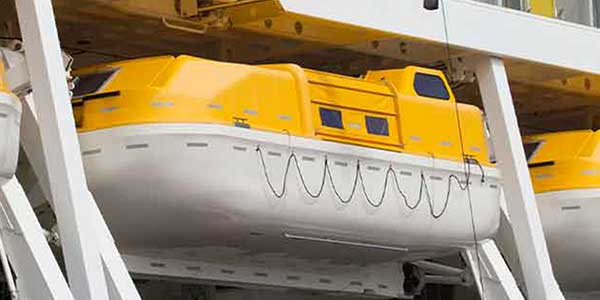
Partially-enclosed lifeboats offer the next level of protection above an open lifeboat. The foldable canopy gives occupants protection from the weather.
They are “partially-enclosed” because they are partially covered by a rigid cover. At least 40% of the boat will be covered by a permanent, rigid cover.
“Partially enclosed lifeboats shall be provided with permanently attached rigid covers extending over not less than 20% of the length of the lifeboat from the stem and not less than 20% of the length of the lifeboat from the aftermost part of the lifeboat”
LSA Code
Partially-enclosed lifeboats are common on passenger ships because they have large, foldable canopies. These large openings assist with the speed of embarkation of passengers in an emergency.
Passenger ship lifeboats need to be able to be boarded by their full complement of passengers within 10 minutes. Considering their full capacity is usually 150 people, it needs to be as easy as possible for people to board.
Partially-enclosed lifeboats also offer a small degree of comfort. When they are loaded with 150 people, having the ability to open the flexible covers is advantageous. 150 people generate a lot of heat, so it is good to have the option of creating large openings if the sea conditions allow.
When in their stowed position, partially-enclosed lifeboats offer good protection to their machinery and equipment. Radiocommunications equipment can be permanently fitted, without worrying about it being exposed to the weather on the open deck.
Totally-enclosed lifeboats
A totally-enclosed lifeboat is a lifeboat that is provided with a rigid watertight enclosure which completely encloses the lifeboat. They afford the maximum protection from the elements for their occupants.
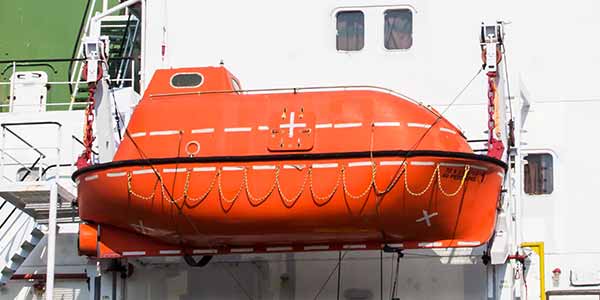
Totally-enclosed lifeboats are designed to give more protection to their occupants than either open or partially-enclosed lifeboats. Their rigid watertight enclosure means that they are much better at keeping occupants safe and dry in adverse conditions.
Despite their total enclosure, however, they do not offer much protection from extremes of temperature.
The crew always need to enter lifeboats wearing clothing suitable for the conditions. In Arctic conditions the clothing required is substantial. As such, the capacity of a totally-enclosed lifeboat in Arctic conditions may be lower than the equivalent boat in other conditions.
Totally-enclosed lifeboats are commonly found on all vessels except passenger ships. The small crew on most commercial vessels means that everyone can embark within the legislative maximum time of 3 minutes.
As a totally-enclosed lifeboat provides better protection than a partially-enclosed lifeboat, they are preferred on cargo vessels whenever they are suitable.
Totally-enclosed lifeboats are inherently self-righting assuming all hatches are closed and sealed, and all occupants are seated with seatbelts in use. This means that in particularly bad weather, they will return upright if they get capsized by the weather.
Within the category of totally-enclosed lifeboats you get several variants with special features: free-fall; hyperbaric; and fire-protected. I’ll cover each of these variants in detail in the sections below.
Free-fall lifeboats
Free-fall lifeboats are totally-enclosed lifeboats that have been designed to be launched from a free-fall davit.

Free-fall lifeboats are designed to be boarded by their full complement of crew in their stowage position in the same way as totally-enclosed lifeboats.
The difference comes in the way they launch. Free-fall lifeboats simply release their securing hook and use gravity to “fall” into the water. They are mounted on angular rails so that the process of “falling” off the ship gives them an element of headway to help them run clear.
Due to their launching technique, they are subjected to forces and dangers that other lifeboats do not experience. They initially experience acceleration at the rate of 9.8m/s2 while in free-fall, then rapid deceleration when they hit the surface of the water.
They are designed to land bow-first so that the boat cuts into the water, spreading the deceleration over a longer time.
Not only does the boat need to be designed to structurally withstand these forces, but it also needs to protect its occupants from them as well.
Free-fall lifeboats will have their seats positioned facing backwards so that occupants are facing the door. This means that their back is against the seat’s backrest for the most dangerous part, the deceleration. It is the same way astronauts are protected during the acceleration of a rocket launch.
The coxswain’s position is often able to rotate so that they can face aft during launching, then turn to face forward for navigation.
You will most commonly find free-fall lifeboats in locations that would require a rapid evacuation in an emergency.
On ships, this commonly includes oil tankers, gas carriers, chemical tankers and product tankers. Bulk carriers are the next most common, due to the speed that they could break apart. Then less commonly you will find them on other vessels like car carriers, general cargo ships and container ships.
Free-fall lifeboats are also common in the offshore industry on oil rigs and platforms.
Hyperbaric lifeboats
Hyperbaric lifeboats are totally-enclosed lifeboats which contain an integrated hyperbaric chamber, designed for use by saturation divers living in a pressurised environment.
Hyperbaric lifeboats are a highly specialised type of lifeboat that is carried onboard dive support vessels for use by saturation divers.
When divers work in deep water, ordinarily they would need to spend hours, or sometimes days, decompressing after each dive. To get around this, dive support vessels bring them up in a pressurised pod, which connects to a fully pressurised environment onboard the vessel. Divers live in this pressurised environment rather than decompressing every time.
In an emergency, they need a way of escaping from the vessel just like the rest of the crew. As it is not possible to decompress quickly, they have their own lifeboats which are fully pressurised just like their living conditions. These are hyperbaric lifeboats.
Hyperbaric lifeboats are designed to the same lifeboat specifications as totally-enclosed lifeboats, but they have additional hyperbaric capabilities. They contain a complete life support system, designed to sustain their occupants for at least 72 hours.
The idea is that the lifeboat can sustain its occupants for three days, during which they will be transferred to a reception facility on land or on another vessel where they can safely decompress and receive medical attention.
JFD is one supplier of these hyperbaric lifeboats, so if you want more information you can read their brochure: JFD Brochure.
Lifeboats with a self-contained air support system
Lifeboats with a self-contained air support system are totally-enclosed lifeboats which can maintain a safe and breathable atmosphere for at least 10 minutes with all entrances and openings closed.
Totally-enclosed lifeboats are great for a rapid escape from a vessel, but it can still take a little time to move away to a safe distance. If the cargo from the vessel is burning, there could be a toxic atmosphere which a lifeboat needs to safely navigate through.
This is where lifeboats with a self-contained air support system come in. They are designed to keep the air inside the boat safe and breathable while it navigates to a safe location.
Their openings have an airtight seal against the environment so that the toxic atmosphere does not get inside.
With the boat sealed, the self-contained air support system maintains an air pressure slightly above that of the atmosphere outside. This ensures any gaps that are not completely airtight result in air escaping the boat rather than toxic air entering.
The self-contained air supply has a capacity for at least 10 minutes of operation. Within 10 minutes, the boat should be able to steam through anything toxic and get its occupants to safety.
Fire-protected lifeboats
Fire-protected lifeboats are totally-enclosed lifeboats with a self-contained air support system that also have a fire protection system capable of protecting its occupants from a continuous oil fire for at least 8 minutes.

Fire-protected lifeboats are an upgrade from lifeboats with a self-contained air support system. The fire protection element allows the lifeboat to navigate through burning oil that may be on the surface of the water.
The usual method of providing fire protection is to fit a drencher system around the lifeboat. Clean water is pumped in from underneath the lifeboat and sprayed over the solid coverings.
Its primary purpose is to keep the outside of the lifeboat cool to protect it from damage from burning oil. Effectively, the system is giving “boundary cooling” to the lifeboat.
As the boat navigates away from danger, oil on the water’s surface may be sprayed up onto the deck. The drencher system washes it straight off, and at the same time, it keeps the surface of the craft cool from the flames.
Fire-protected lifeboats are typically fitted to vessels carrying products that could ignite on the surface of the water. Oil tankers, product tankers and even oil rigs are examples of use cases for fire-protected lifeboats.
Lifeboat tenders
Lifeboat tenders are partially-enclosed lifeboats that have been specifically designed to operate as passenger-carrying tenders. They are commonly found on cruise ships.
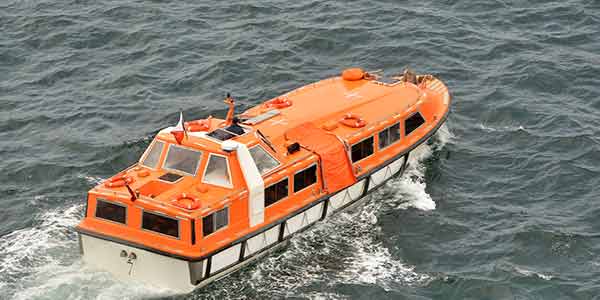
In their capacity as a lifeboat, lifeboat tenders meet the design specifications of partially-enclosed lifeboats. The main difference is that they usually have a greater percentage of their surface covered by fixed coverings than regular partially-enclosed lifeboats.
A partially-enclosed lifeboat only needs 40% of its surface to be covered by a rigid cover. The rest can be covered by fixed flexible coverings.
Lifeboat tenders are likely to only have flexible coverings over a standard-sized entrance. Their entrances will still be big enough to allow the full lifeboat capacity to board within 10 minutes in an emergency.
They are also designed to offer more comfort to passengers, so there will be a lot more seating and windows. You’ll often find cushions in place, although these are usually only fitted during tendering operations.
Lifeboat tenders are certified as passenger carrying vessels in their own right. They have more redundancy in their engines and better navigation equipment than standard lifeboats. Additionally, they carry a full complement of lifejackets, which is not required on a lifeboat.
The reason lifejackets are not required on lifeboats is that everyone is expected to board the boat already wearing their lifejacket. With a tender, passengers will not usually have life jackets on unless there is an emergency.
When operating in a tendering capacity, the maximum capacity will be different from the same vessel operating as a lifeboat. Lifeboats have a maximum capacity of 150 persons, but as a tender, the capacity will be nearer to 100 persons.
Rescue boat
A rescue boat is a craft between 3.8m and 8.5m in length that is carried onboard another vessel and intended to be used for rescuing persons from the water or marshalling liferafts. Rescue boats can be rigid, or inflatable, or rigid-inflatable boats.
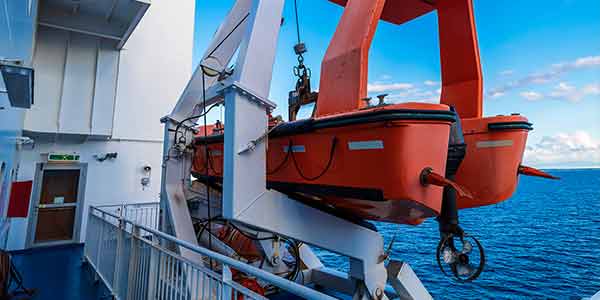
Rescue boats are small craft, usually launched by a single davit. They can have either an outboard or an inboard engine and are sized according to the vessel they are carried on.
A rescue boat needs enough power to tow the ship’s largest liferaft at a speed of at least 2kn. On its own, it needs to be able to steam at 6kn for at least 4hrs.
Their manoeuvrability needs to be such that they can efficiently retrieve persons from the water and marshall liferaft.
As they are designed for rescue, they need to be able to fit a stretcher laid down, in addition to 5 seated people.
Rescue boats are carried on all ships. Every ship needs one rescue boat, and passenger ships over 500 GRT need at least one on each side. The rescue boat may be substituted with a fast rescue boat instead, but that is designed for the same purpose.
Fast rescue boat
A fast rescue boat is a craft between 6m and 8.5m in length, intended to be used for rescuing persons from the water and marshalling liferafts. Fast rescue boats can manoeuvre at a speed of at least 20kn for at least 4hrs.
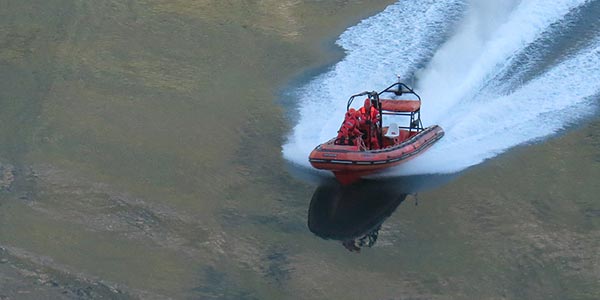
Fast rescue boats must fit the same basic criteria as rescue boats. They need to be able to retrieve people from the water and tow the ship’s largest liferaft at a speed of at least 2kn. They also have the same requirement of carrying 5 people and a stretcher which is laid flat.
In addition to the basic rescue boat requirements, fast rescue boats need to be able to maintain a speed of at least 8kn while fully loaded.
With a crew of three, the fast rescue boat must be able to maintain a speed of at least 20kn for at least 4hrs.
Fast rescue craft are found on all sorts of different ships, but the main example of carriage of fast rescue boats is on passenger ships. The above image is one that I took of a fast rescue boat from a cruise ship.
Liferafts
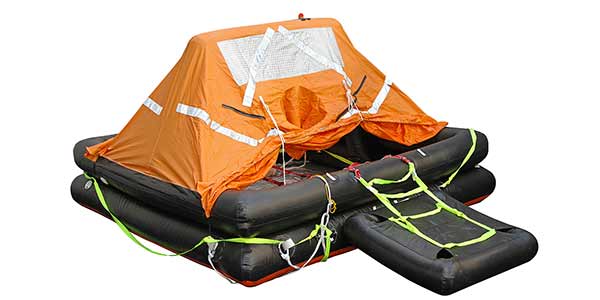
Although they are not classified as a lifeboat, I have included liferafts at the end of this article for completeness.
Liferafts are used for evacuations from ships in the same way as lifeboats are. The main difference being that a liferaft is inflatable and does not have its own propulsion system.
The rescue boats that we discussed in the previous section are designed to work with liferafts. The intention is that the rescue boats can pull liferafts away from a sinking ship.
On passenger ships where there are a significant number of liferafts, powered lifeboats can also be used to marshal liferafts. Fast rescue craft will pull liferafts away from the side of the ship, then the lifeboats can take over.
Within the category of liferafts, you will find “Marine Evacuation Systems”, or M.E.S. An M.E.S. is like a liferaft, but significantly larger. It deploys from its stowage location, dropping down to the water where it inflates.
As the MES drops to the surface, it deploys a slide which is used to embark everyone safely at the water’s surface. This eliminates the need for lowering liferafts on davits as you would with conventional liferafts.
Once fully embarked, rescue boats or lifeboats are used to pull the M.E.S. away from the side of the ship to a safe distance.
